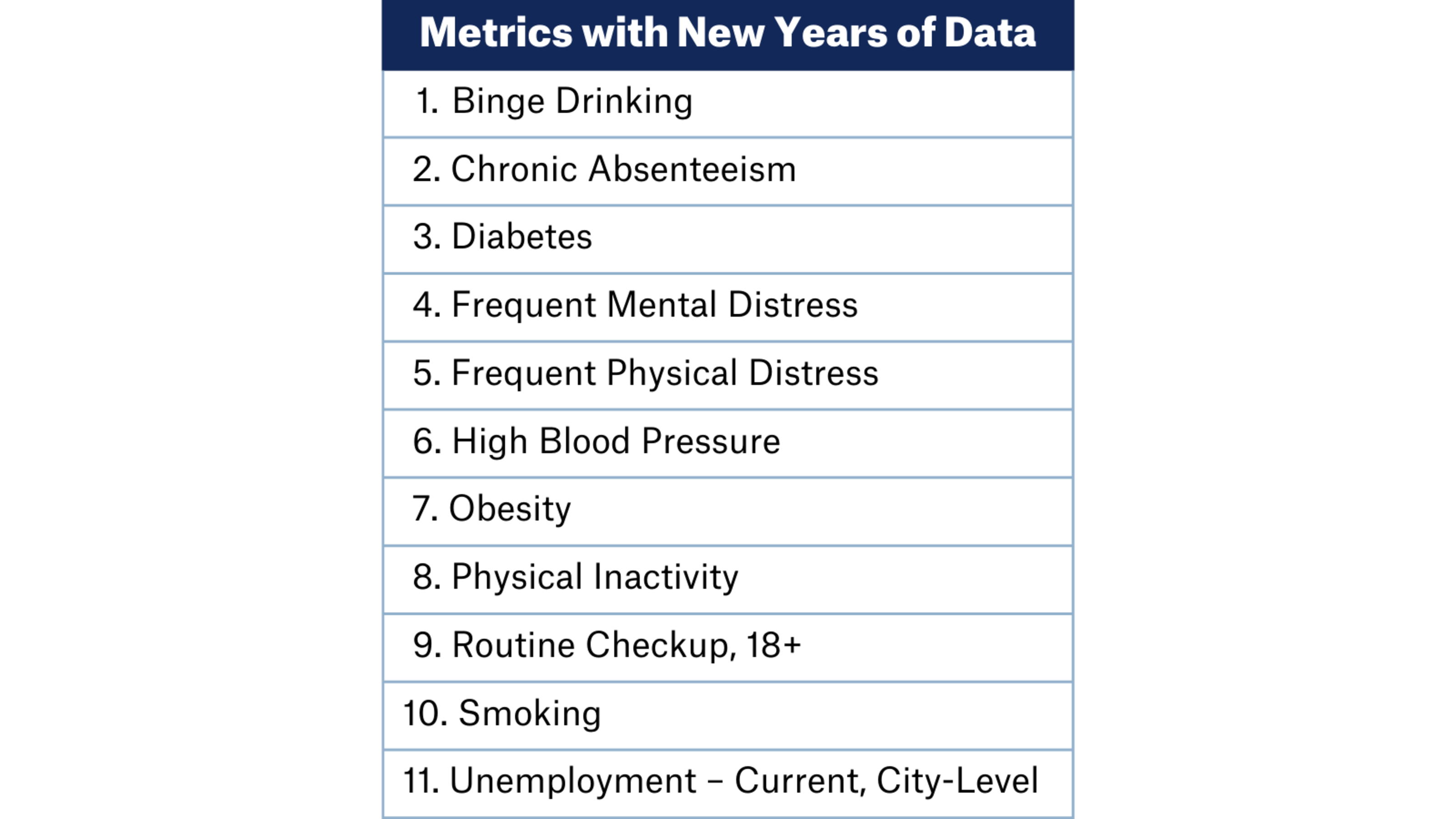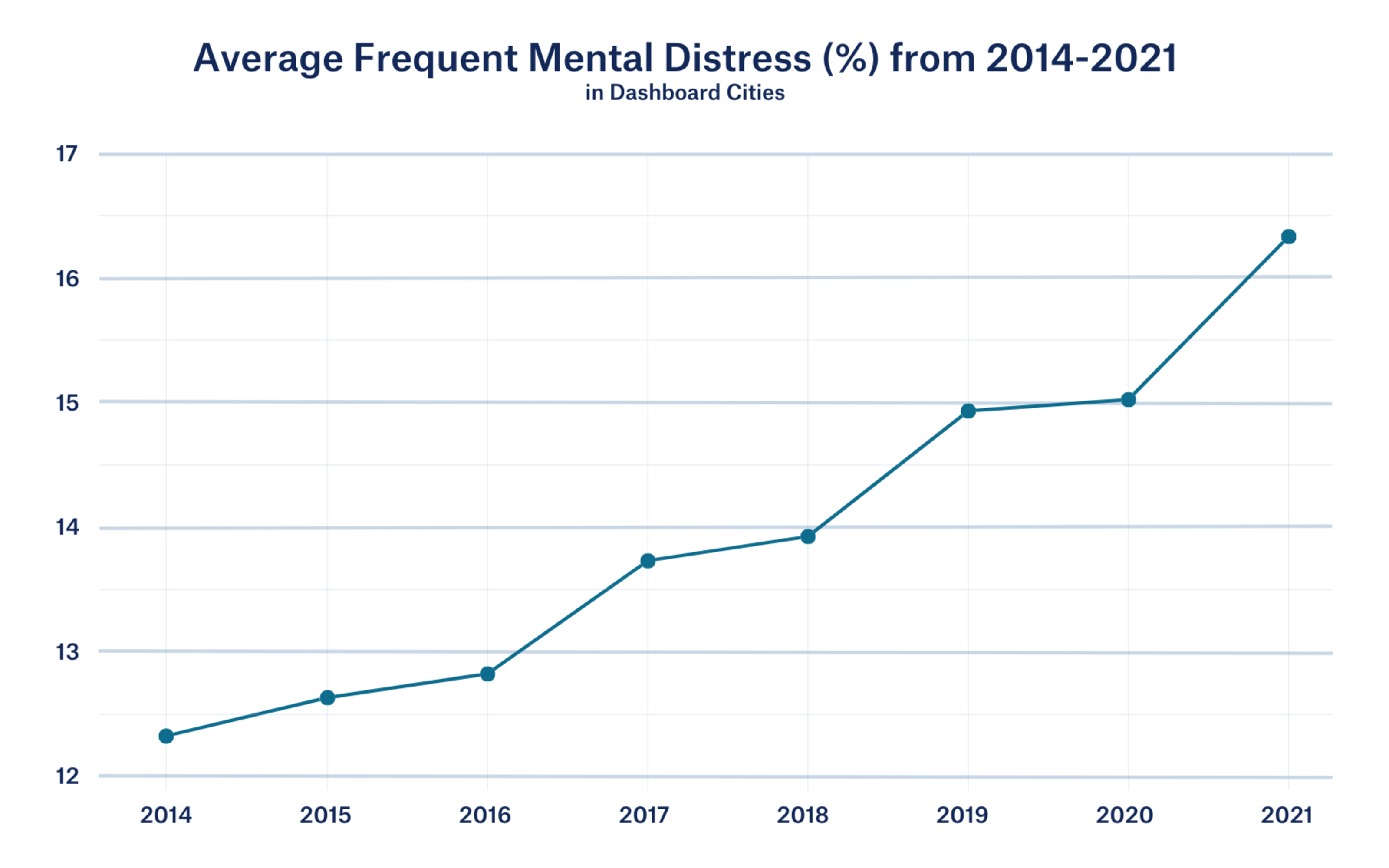Autumn Updates: The Latest Dashboard Data Release
Dec. 6, 2023
Caleigh Paster
As the leaves change, so does the City Health Dashboard! This Fall, we’re marking the end of the year with a data release, keeping with our promise to provide the most up-to-date data for our users.
This release includes new years of data for 11 metrics, as well as highlights on historic trends in Frequent Mental Distress, a spotlight on Chronic Absenteeism, and an announcement of the reestablishment of our API to retrieve multi-year data.
Read on to learn more.
New Years of Data
This data release introduces new years of data for 11 metrics. Among those with updates includes 9 metrics from the PLACES Project with data through 2021, Chronic Absenteeism (previously referred to as Absenteeism) with data through 2022, and Unemployment – Current, City-Level with months of data now through July 2023. See below for a full list of metrics with updated data.

For the Chronic Absenteeism metric, we have updated our data source to reflect data collected by the National Center for Education Statistics and the U.S. Department of Education, allowing us to capture data for school years spanning from the 2017-2018 school year through 2022. Unfortunately, due to limited national data availability, data for school year 2018-2019 (listed as “2019”) is excluded. This is a significant increase in years of availability, demonstrating our continued commitment to providing more data for all metrics, when available.
The Latest in Trends
Rising Frequent Mental Distress Continues
Frequent Mental Distress has been on the rise in cities and public health campaigns have worked hard to raise awareness of this ongoing mental health crisis, including a recent Surgeon General’s Advisory on the epidemic of loneliness. Despite these new initiatives, new years of data continue to show a steady increase in frequent mental distress nationwide.

When looking closer at the data, college cities – defined by the Dashboard’s City Type Report – and towns nearby to college campuses consistently had among the highest levels of frequent mental distress. Notably, the three cities with the highest rates of Frequent Mental Distress also had similar population sizes (between 20,000 and 40,000) and were located in the Midwest. There are a few potential reasons as to why college towns might be experiencing higher levels of frequent mental distress, including increased access to services, challenges adjusting to adulthood during the current era (ex. economic strain, mass shootings and other violence, COVID-19, and social injustice), as well as increased stress for faculty members.
Local data on mental health can provide evidence for prioritizing this wide-spread, urgent public health concern and enhancing our policy and programmatic response to best support our residents and communities.
Explore Frequent Mental Distress in your city.
How School Attendance Has Shifted Over the Years
Earlier this year, the U.S. government declared the COVID-19 pandemic over, marking a new post-pandemic stage for the country and the health needs of all of our communities. With data available through 2021, and in some cases 2022, we now have an opportunity to look back on the last few years to understand COVID’s sweeping health, social, and economic impacts. One metric in particular has shown trends that punctuate this point quite clearly: Chronic Absenteeism from 2020-2022.
Since the start of the COVID-19 pandemic, average Chronic Absenteeism rates have fluctuated as schools experienced major disruptions in learning environments. On average, Chronic Absenteeism rates rose significantly starting in school year 2020-2021 (listed as “2021” on the Dashboard) and have yet to return to their pre-pandemic values. In fact, according to data published on the most recent school year, rates are still increasing in many communities. This indicates a notable trend of continued higher Chronic Absenteeism rates despite the decrease in COVID risks and many schools returning to a fully in-person attendance model. As with all Dashboard data, it is crucial to view this metric within the context of these larger societal forces and to avoid attributing any change in values to just one factor. Stay tuned for a Dashboard blog that will dig deeper into these findings, providing context to understand these Chronic Absenteeism trends, and help you use data to monitor recovery efforts.
Explore Chronic Absenteeism in your city.
Improving the User Experience: Updates to the API
We are happy to announce that access to the API has been restored on the Dashboard as of October 25th. After this past summer’s data release, we temporarily disabled the API due to a site restructuring that improved the Dashboard’s speed and user experience. With access restored, we are pleased to continue offering multi-year data for download, including the data updated in this release. As a reminder, the Dashboard team is always available to answer any data questions by emailing us at [email protected].